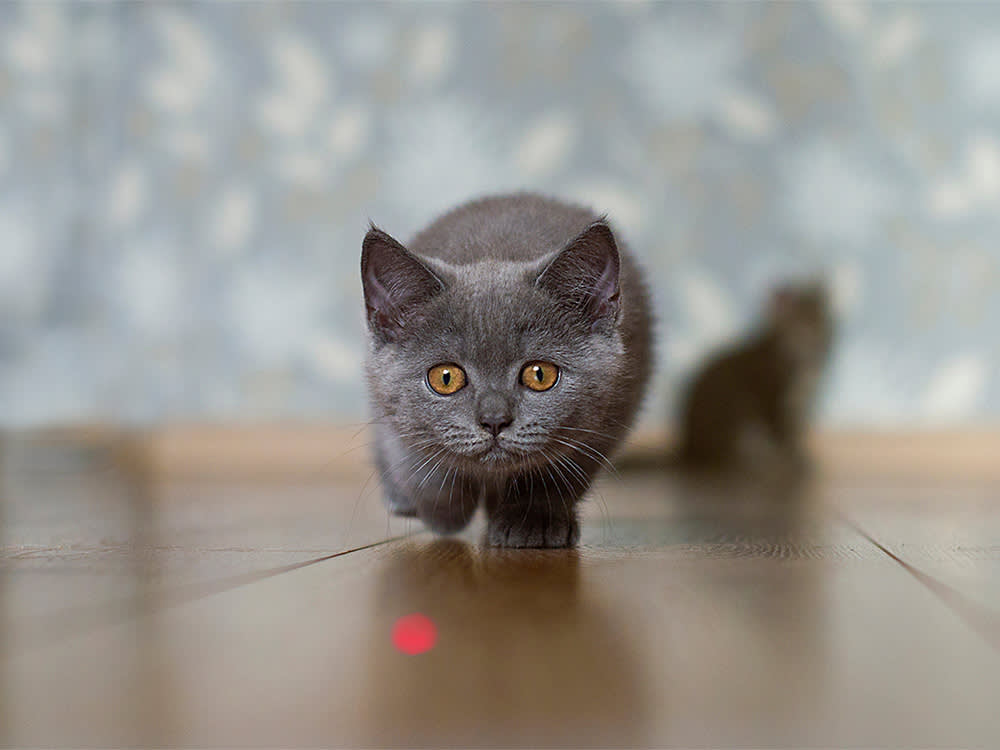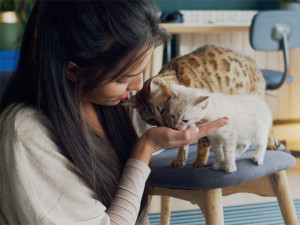Get to the Point: Can Cats Play With Laser-Pointer Toys?
People have strong opinions about this cat toy. Here’s what you need to know

Share Article
Watching cats play is hilarious; they jump off of every surface, bat their little paws at anything you dangle in front of them, and get absolutely fixated on the silliest things. We need to watch them play (and need to play with them) to be happy – and to get all that pent-up kitty energy out. That’s why some cat parents are resistant when they hear their cats can’t play with certain toys. One of the most polarising cat toys? Laser pointers.
Some people say that laser pointers are the best toy ever for our cats, and some people deliver warnings about the horrors facing you and your cat if you ever allow your cat to play with a laser pointer. Personally, I am among the hordes of dog trainers and canine behaviourists who regularly advise against using laser pointers because of the risks associated with them, but I’m practical, too.
For my clients who insist on laser-pointer play with their cats, I offer advice to minimise those risks – affording them the opportunity to make their own choices based on the best information I can offer. As with most issues, there’s a middle ground – there are potential dangers of playing with your cat using a laser pointer. But such play can be done in a way that prioritises safety. Here’s what you need to know about making use of laser pointers when playing with your cat.
The upside: why it’s so tempting to play with them
Laser pointers are popular for a reason. Many cats find them riveting, and they can be kept occupied for a long time by the quickly moving and unpredictable red dot of light. The ease of moving the light around the room even if you are doing something else – sitting, drinking coffee, planning your weekend etc – by using a laser pointer means you can give your cat mental and physical exercise while you kick your feet up and relax on the sofa. On top of that, it’s fun to watch cats endlessly stare, stalk, chase and pounce all about the house.
The downside: problems with lasers
Let’s begin with that word ‘endlessly’. The biggest issue with laser-pointer play is the frustration many cats experience when they stalk, chase and pounce on the light without ever completing the hunting sequence. It’s the joy of the hunt that keeps many cats so enthusiastic about play. They love to stalk, chase, pounce, catch and bite toys, but with the laser pointer, there is nothing to catch and nothing to bite. They endlessly attempt to catch the ‘prey’ and never can.
In many cases, that leaves cats still revved up after a laser pointer play session ends. They may go after inappropriate targets that move, and that means the feet, hands, jackets, bags and trousers of everyone in the house, as well as other pets, may be subject to attack. According to research, playing with lasers is associated with abnormal repetitive behaviours, especially chasing lights and shadows. That may be a result of the frustration and stress, which are risk factors for the development of compulsive behaviours. Another concern is that laser pointers can cause permanent damage to the eyes of cats, dogs and people.
How to use lasers while minimising the damage they can cause
As in life itself, success with that little red dot is all about taking advantage of the good opportunities while minimising the negative aspects. And yes, this is possible even with controversial laser pointers if you are truly committed to such play. But if your cat starts to show negative side effects, please stop and remove laser pointers from your repertoire. Most important, don’t shine the light in anyone’s eyes! It’s an obvious point, but I would feel irresponsible if I didn’t mention it while discussing how to play safely.
There are several ways to avoid the frustration associated with the inability of the cat to end the hunting sequence with a success. You can start with the laser pointer at the beginning of a play session and transition to another toy they actually can catch. Wand-like toys with something moving on the end are great, as are stuffed fleece or crinkly toys. You can also point the red dot to direct cats to one of the toys scattered around on the floor, and then turn off the light when they ‘catch’ it.
For cats who have been trained using a clicker, you can click to indicate they have been successful in their hunt of the light and then give the cat a high-quality treat. You can decide what behaviour merits a click, such as when the cat pounces where the dot is, or when the cat is particularly quick in its attempt to capture the dot. Have fun, keep it safe, and may you be the biggest light in your cat’s life.

Karen B. London, PhD, CAAB, CPDT-KA
Karen B. London, Ph.D., is a Certified Applied Animal Behaviorist and Certified Professional Dog Trainer who specializes in working with dogs with serious behavioral issues, including aggression, and has also trained other animals including cats, birds, snakes, and insects.
Related articles
![kittens licking woman's hand]()
Curious Cat Behaviour: Why Does My Cat Lick Me?
Hey, everybody’s got their thing
![Happy stylish latino queer person looking comfortable on porch steps with gray cat.]()
Cats Lifespan: How Long Do Cats Live?
They are the absolute light of your life. Here’s how you can help them live as close to forever as possible
![Young woman hugging her cat]()
Why Do Cats Purr?
Surprise: it doesn’t always mean they’re happy
![A cat headbutting a woman on her laptop.]()
Why Does Your Cat Headbutt You? Curious Cat Behaviour Explained
Apparently, you should take it as a compliment
![White cat switching on lamp on couch]()
Why Does Your Cat Wake You Up at Night?
You want to sleep, your cat wants to party. Here’s how to deal with it







